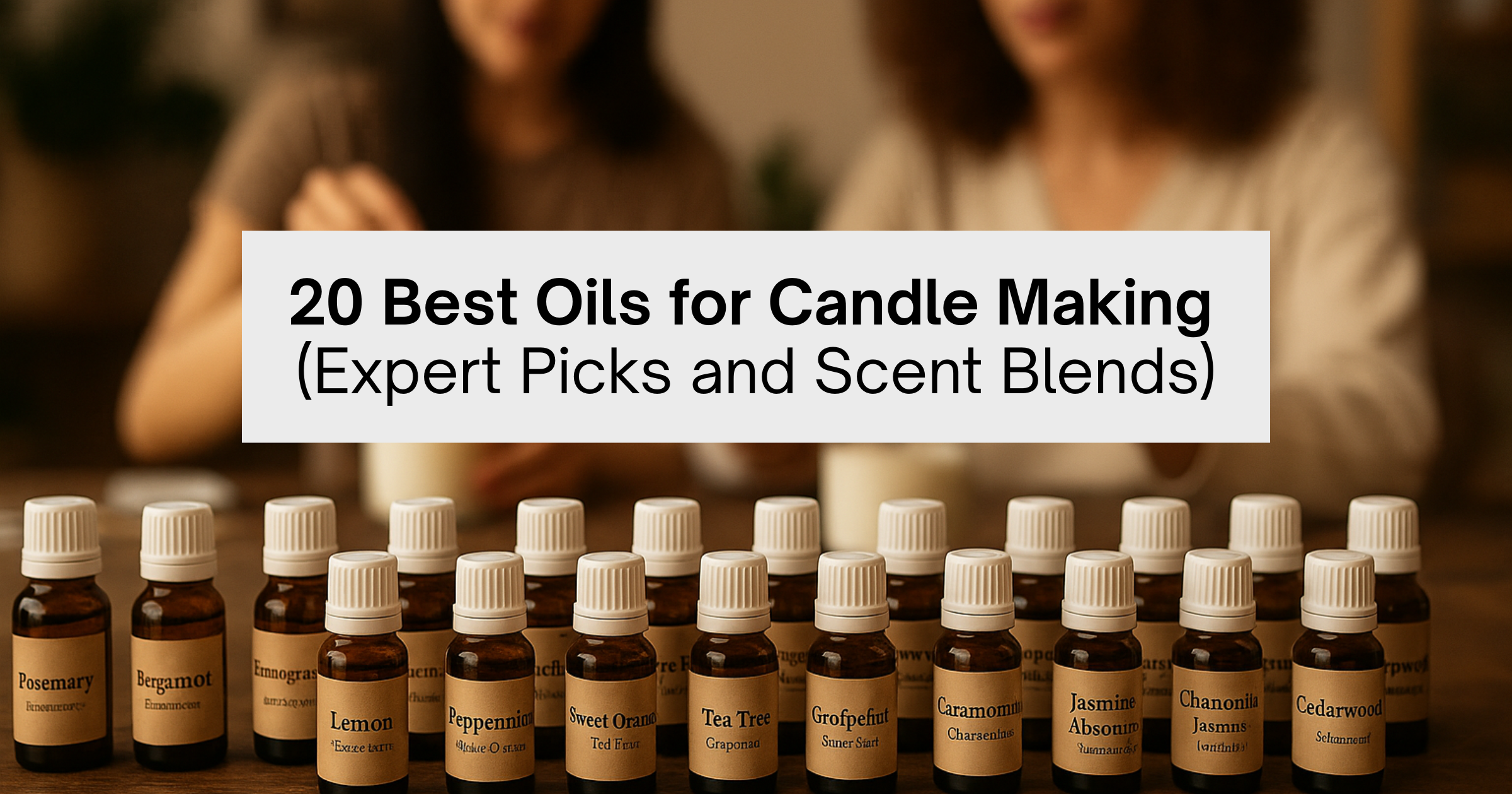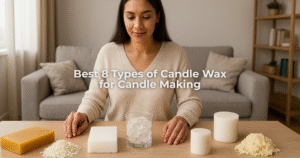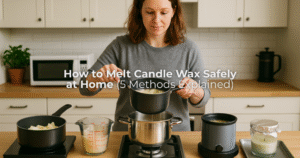20 Best Oils for Candle Making (Expert Picks and Scent Blends)

If you’ve ever poured your heart into a candle, only to light it later and think, “Hmm… where did that scent go?”, you already know — picking the best oils for candle making isn’t just about fragrance.
It’s about how that fragrance behaves in wax, how it throws in a room, and even how it evolves as the candle burns.
I’ve been making candles for nearly a decade now, from small soy jar candles on my kitchen counter to large-batch pours for boutique orders.
And trust me, I’ve had my fair share of scent disasters (lavender that turned weirdly medicinal, citrus that disappeared after a week).
Over time, I’ve learned that the right oils can make the difference between a candle that gets lit once and forgotten… and one that becomes someone’s all-time favorite.
This guide will explore the 20 best essential and scent oils for candle making I’ve personally tested, whether you’re after that perfect best candle scent oil for a cozy winter vibe or a clean, spa-like best essential oil candle for your bathroom shelf.
These aren’t random picks; they’re oils that have proven their worth in both scent throw and burn quality.
The 20 Best Oils for Candle Making
1. Lavender Essential Oil
When people think of candle scents like vanilla or lavender is often the first that comes to mind — and for good reason.
It’s calming, universally loved, and blends beautifully with other oils. The lavender I use is French lavender with a slightly sweet, floral profile (English lavender tends to be sharper).
Aroma Profile: Soft, floral, slightly herbaceous with a hint of sweetness.
Why It’s Great for Candle Making: Lavender essential oil has an excellent cold throw — you can smell it even before you light the candle.
When warmed, it deepens into a more rounded floral that’s incredibly relaxing. I’ve found it holds up well in soy and coconut wax without fading too quickly.
Blend Ideas:
- Lavender + Vanilla = Comforting bedtime candle.
- Lavender + Eucalyptus = Spa-day vibes.
2. Eucalyptus Essential Oil
Eucalyptus isn’t just “fresh” — it’s invigorating in a way that clears the head and sharpens the senses. I first added it to candles after a customer requested something for their yoga space.
Aroma Profile: Crisp, green, camphorous with subtle mint undertones.
Why It’s Great for Candle Making: Strong hot throw — even in small spaces. In my experience, eucalyptus is one of the few oils that can stand alone and still feel complete.
It also blends well with citrus or florals to add complexity.
Blend Ideas:
- Eucalyptus + Lemon = Energizing morning scent.
- Eucalyptus + Lavender = Perfect for meditation candles.
3. Lemon Essential Oil
Here’s the thing with lemon — it’s bright and clean, but it can be tricky. In soy wax candle making, you need a good-quality lemon essential oil with a high scent load, or it’ll disappear fast.
Aroma Profile: Zesty, fresh, slightly sweet citrus.
Why It’s Great for Candle Making: Lemon instantly makes a room feel fresher. It’s uplifting without being overpowering. I’ve used it in “kitchen” candles to neutralize lingering cooking smells — works like a charm.
Blend Ideas:
- Lemon + Rosemary = Fresh herb garden.
- Lemon + Eucalyptus = Crisp and energizing.
4. Peppermint Essential Oil
Peppermint candles are polarizing — some love that icy freshness, others find it too sharp. I love using it in winter blends, where it reminds me of peppermint bark and snowy evenings.
Aroma Profile: Cool, minty, with a sweet undertone.
Why It’s Great for Candle Making: Strong scent throw in both hot and cold. A little goes a long way — too much and it can be overwhelming. Best used in moderation or blended with something softer.
Blend Ideas:
- Peppermint + Vanilla = Candy cane holiday candle.
- Peppermint + Eucalyptus = Fresh and invigorating.
5. Sweet Orange Essential Oil
If I had to pick the happiest oil on this list, it’s sweet orange. It’s not as sharp as lemon, not as bitter as grapefruit — it’s just… sunshine in a bottle.
Aroma Profile: Sweet, juicy, with a hint of zest.
Why It’s Great for Candle Making: In my experience, sweet orange has a more reliable throw than other citrus oils. It blends seamlessly into both fruity and spicy candles. Plus, it’s affordable, making it great for beginners testing their best candle scent oils.
Blend Ideas:
- Sweet Orange + Cinnamon = Warm autumn blend.
- Sweet Orange + Clove = Spiced holiday scent.
6. Tea Tree Essential Oil
This one surprises a lot of people — tea tree isn’t just for skincare. When used correctly, it gives a clean, almost medicinal freshness that works beautifully in minimalist, “clean air” candles.
Aroma Profile: Fresh, herbal, slightly medicinal.
Why It’s Great for Candle Making: Tea tree blends well with citrus for a “clean home” vibe. I’ve also used it in soy candles for bathrooms where a refreshing scent is welcome.
Blend Ideas:
- Tea Tree + Lemon = Crisp and clean.
- Tea Tree + Lavender = Balanced and calming.
7. Ylang Ylang Essential Oil
Ylang ylang is one of those oils you either adore or avoid. I adore it — but only in the right proportions. Too much, and it can feel cloying.
Aroma Profile: Exotic, floral, sweet with a hint of spice.
Why It’s Great for Candle Making: Adds depth and sensuality to floral blends. I use it in romantic candles because it has that rich, slightly mysterious quality.
Blend Ideas:
- Ylang Ylang + Sandalwood = Luxurious evening scent.
- Ylang Ylang + Jasmine = Bold floral bouquet.
8. Cinnamon Leaf Essential Oil
Cinnamon is tricky — cinnamon bark oil can be harsh and irritating, so I stick with cinnamon leaf, which is softer but still wonderfully spicy.
Aroma Profile: Warm, spicy, slightly woody.
Why It’s Great for Candle Making: Perfect for fall and holiday candles. In my experience, cinnamon works best when it’s not the only note — blend it, and it will shine without overpowering.
Blend Ideas:
- Cinnamon + Orange = Cozy kitchen scent.
- Cinnamon + Vanilla = Classic holiday comfort.
9. Rosemary Essential Oil
Rosemary in candles is like fresh herbs in cooking — it lifts everything. I once added it to a lemon blend and was blown away by how clean yet grounding it felt.
Aroma Profile: Herbal, piney, slightly camphorous.
Why It’s Great for Candle Making: Strong throw and a refreshing, green note that works year-round. Especially good for candles aimed at focus or study spaces.
Blend Ideas:
- Rosemary + Lemon = Bright and herbal.
- Rosemary + Eucalyptus = Green, spa-like scent.
10. Bergamot Essential Oil
Bergamot is my “secret weapon” oil. If a blend feels flat, a few drops of bergamot make it sparkle.
Aroma Profile: Citrusy with a floral twist, slightly spicy.
Why It’s Great for Candle Making: It’s a natural mood-lifter. Works beautifully in both floral and citrus blends, and my experience, it performs well even after months of storage.
Blend Ideas:
- Bergamot + Lavender = Sophisticated spa blend.
- Bergamot + Patchouli = Earthy yet bright.
11. Lemongrass Essential Oil
Lemongrass is one of those oils that completely transforms a room.
The first time I made a lemongrass candle, I accidentally spilled some on my workbench — the entire studio smelled like a tropical spa for hours.
Aroma Profile: Bright, citrusy, with grassy and herbal undertones.
Why It’s Great for Candle Making: Lemongrass has a sharp yet smooth scent that cuts through heavier blends, adding freshness without becoming overpowering.
In my experience, it’s one of the best scent oils for candle making when you want a “clean and uplifting” vibe. Works beautifully in soy, coconut, and beeswax.
Blend Ideas:
- Lemongrass + Eucalyptus = Crisp and refreshing.
- Lemongrass + Ginger = Energizing and exotic.
12. Frankincense Essential Oil
Frankincense is my go-to when I want a candle to feel grounding and meditative. I started using it after making candles for a local yoga teacher, and it’s been a staple ever since.
Aroma Profile: Warm, resinous, slightly woody with a hint of spice.
Why It’s Great for Candle Making: It adds depth and sophistication to blends, especially when paired with woods or spices.
Strong hot throw and excellent staying power — months later, the scent still lingers beautifully.
Blend Ideas:
- Frankincense + Myrrh = Classic, sacred aroma.
- Frankincense + Sandalwood = Deep and calming.
13. Clove Bud Essential Oil
Clove bud oil smells like autumn in a bottle. The first time I used it, I paired it with sweet orange, and it instantly became my best-selling holiday candle.
Aroma Profile: Warm, spicy, rich, with a hint of sweetness.
Why It’s Great for Candle Making: Clove has a robust throw — you don’t need much to make a statement. Perfect for festive blends or cozy winter scents. Works well with citrus to balance the spice.
Blend Ideas:
- Clove + Orange = Holiday classic.
- Clove + Vanilla = Spiced dessert vibe.
14. Patchouli Essential Oil
Patchouli has a bit of a reputation — people either think of it as “hippie perfume” or they fall in love with its earthy richness.
I think it’s one of the most underrated oils for candle making when used thoughtfully.
Aroma Profile: Earthy, musky, slightly sweet with woody undertones.
Why It’s Great for Candle Making: It anchors lighter scents, giving blends a long-lasting base note. I’ve used it in everything from grounding meditation candles to upscale floral blends.
Blend Ideas:
- Patchouli + Bergamot = Earthy yet bright.
- Patchouli + Lavender = Balanced and calming.
15. Grapefruit Essential Oil
Grapefruit is citrus with a twist — it’s fresher and more complex than lemon or orange. I use it in candles meant to feel energizing without being sharp.
Aroma Profile: Bright, tangy, slightly bitter-sweet citrus.
Why It’s Great for Candle Making: Grapefruit works beautifully in summer or “morning” candles. It blends with both florals and herbs, making it versatile.
The cold throw is fantastic — I’ve had people comment on unlit grapefruit candles sitting on a shelf.
Blend Ideas:
- Grapefruit + Mint = Fresh and energizing.
- Grapefruit + Rosemary = Green and bright.
16. Chamomile Essential Oil
Chamomile isn’t just for tea — it makes an incredible candle scent, especially for relaxation blends. I started using it in bedtime candles for friends, and it became an instant hit.
Aroma Profile: Soft, herbal, slightly sweet with apple-like notes.
Why It’s Great for Candle Making: Gentle and soothing, chamomile works best in blends but can stand alone for a subtle, calming candle.
I’ve found it pairs beautifully with lavender for a “sleepy time” candle.
Blend Ideas:
- Chamomile + Lavender = Bedtime blend.
- Chamomile + Vanilla = Soft and comforting.
17. Jasmine Absolute (Oil Blend)
Jasmine is a luxury in a scent. The first jasmine candle I made was for a wedding — the bride wanted something “romantic but not too sweet” and jasmine delivered perfectly.
Aroma Profile: Rich, floral, sweet, and intoxicating.
Why It’s Great for Candle Making: A little goes a long way. Jasmine adds elegance and complexity to floral blends. In my experience, it’s one of the best candle scent oils when you want a romantic or high-end feel.
Blend Ideas:
- Jasmine + Ylang Ylang = Exotic floral bouquet.
- Jasmine + Sandalwood = Soft and sensual.
18. Sandalwood Essential Oil
Sandalwood is my favorite base note. It’s smooth, woody, and feels grounding without being heavy.
Aroma Profile: Warm, creamy, woody with soft balsamic undertones.
Why It’s Great for Candle Making: Sandalwood adds depth to both masculine and feminine blends.
I’ve used it as the foundation for meditative candles and luxury gift lines. Holds up extremely well over time.
Blend Ideas:
- Sandalwood + Vanilla = Rich and comforting.
- Sandalwood + Lavender = Relaxing and sophisticated.
19. Geranium Essential Oil
Geranium is floral but not in an overpowering way — it has a freshness that balances the sweetness. I first tried it in a summer garden blend and was surprised at how well it paired with citrus.
Aroma Profile: Floral, rosy, with green and slightly minty notes.
Why It’s Great for Candle Making: Versatile and uplifting, geranium works in both floral and herbal blends. Excellent for spring and summer candles.
Blend Ideas:
- Geranium + Lemon = Fresh and floral.
- Geranium + Bergamot = Bright and uplifting.
20. Cedarwood Essential Oil
Cedarwood is like walking into a cabin in the woods — warm, earthy, and inviting. I use it as a grounding base note in many of my masculine blends.
Aroma Profile: Woody, dry, with a subtle sweetness.
Why It’s Great for Candle Making: Long-lasting scent and excellent as a blending anchor. Works beautifully in autumn and winter candles, or year-round for rustic, nature-inspired lines.
Blend Ideas:
- Cedarwood + Rosemary = Fresh and woody.
- Cedarwood + Orange = Cozy and bright.
Final Thoughts
After years of testing, blending, and making a few terrible-smelling candles along the way, I can say with full confidence that the best oils for candle making aren’t just about personal preference.
They’re about performance, compatibility with your wax, and how the scent evolves.
Some oils shine on their own (like lavender or eucalyptus), while others truly come alive in blends (I’m looking at you, patchouli and bergamot).
My biggest piece of advice? Don’t just pick a fragrance because it smells good in the bottle — test it in your wax, at different scent loads, and in different spaces.
The right scent oils for candle making will feel like magic when you light that wick, and the room transforms.
Candle making is part science, part art, and part patience. So experiment, take notes, and don’t be afraid to surprise yourself.
That’s how I’ve found my best-selling scents — and I promise, your next “happy accident” could become your signature candle.
FAQs on Oils for Candle Making
What is the best candle scent oil for beginners?
In my experience, sweet orange and lavender are great starting points. They’re forgiving, affordable, and work well in most wax types. Plus, their scent throw is reliable even without advanced blending techniques.
Can I mix essential and fragrance oils in candles?
Absolutely. I often combine them to get the best of both worlds — the authenticity of essential oils with the staying power of fragrance oils. Just keep your total scent load within safe limits for your wax type.
Which oils have the strongest hot throw?
Eucalyptus, peppermint, cinnamon leaf, and clove bud are powerhouses. But remember — strong isn’t always better. Sometimes a softer scent with a steady throw (like sandalwood) creates a better overall candle experience.
How much essential oil should I use in a candle?
For most soy or coconut waxes, I stick to around 6–10% of the wax weight. However, this is where testing truly matters. Too much oil can weaken the scent throw or cause performance issues like sweating or uneven burning.
Are all essential oils safe for candle making?
Not quite. Some essential oils have very low flashpoints or can irritate when burned. Always check IFRA guidelines and your supplier’s safety data before using a new oil. I learned this the hard way when my first attempt at a cinnamon bark candle turned into a sooty mess.
-
Nav Preet is the founder and creative soul behind Karigar Candles. Inspired by heritage, nature, and the warmth of handmade artistry, she crafts candles that do more than glow—they evoke emotion. Through this blog, she shares her love for scents, styling, and mindful living, one flame at a time.
Creative Head at Karigar Style







